Nursing Essay: Role of Communication in Patient Safety and Care
VerifiedAdded on 2022/09/13
|6
|1291
|15
Essay
AI Summary
This nursing essay explores the critical role of effective nurse-patient communication in fostering therapeutic relationships and promoting patient safety, ultimately ensuring optimal patient care. It emphasizes that a successful nurse-patient relationship, built on trust, focus, anticipation, understanding, and evaluation, is fundamental to providing primary care. The essay discusses the benefits of effective communication, such as improved diagnosis accuracy, patient satisfaction, treatment adherence, and clinical outcomes, while also highlighting the adverse effects of ineffective communication. It stresses the importance of a patient-safe communication approach, person-centered care, and adherence to professional standards. The essay analyzes a patient scenario to illustrate the application of these principles and concludes that establishing productive nurse-patient relationships and maintaining optimum care goals are essential for healthcare professionals. References from relevant sources are included.
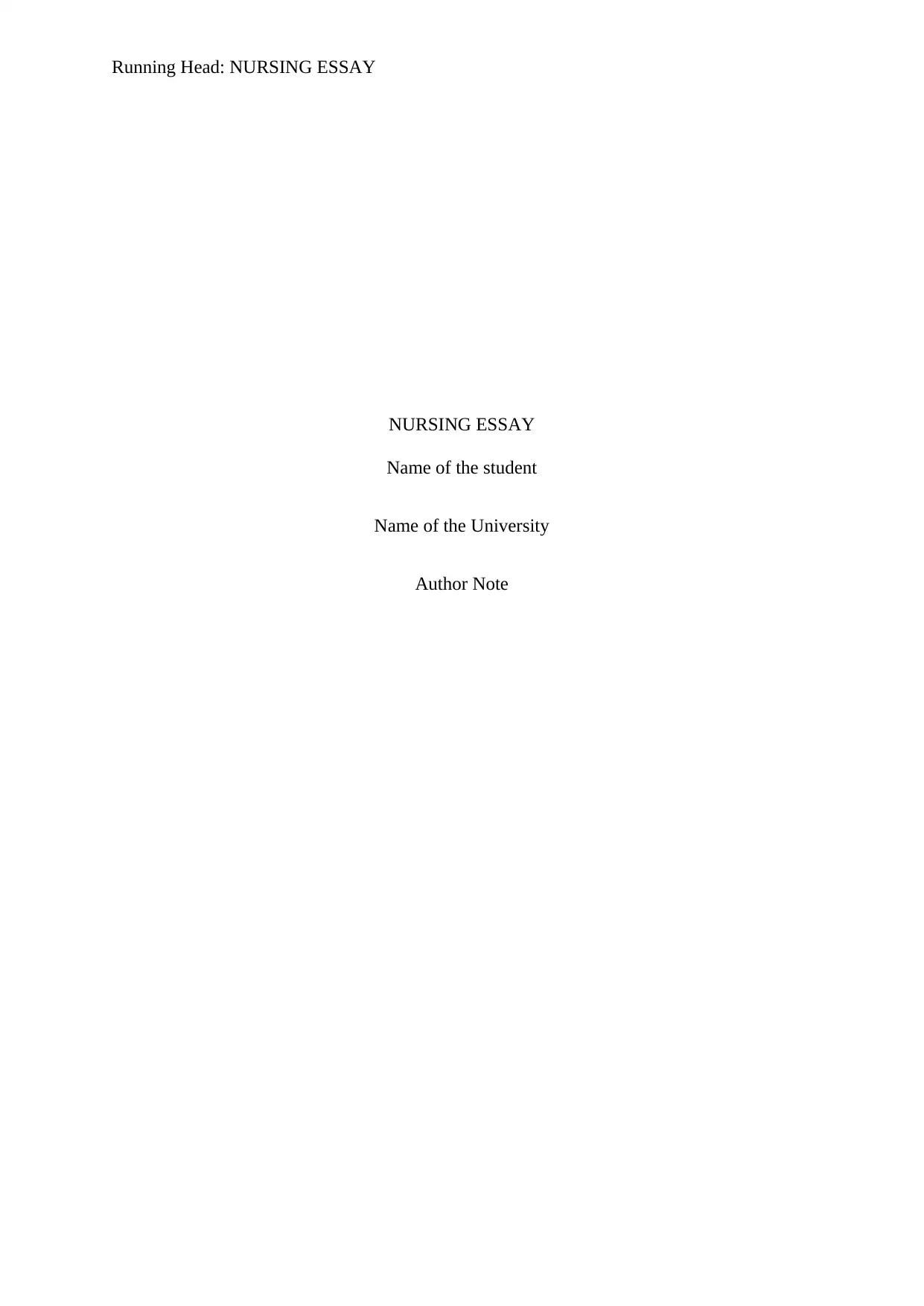
Running Head: NURSING ESSAY
NURSING ESSAY
Name of the student
Name of the University
Author Note
NURSING ESSAY
Name of the student
Name of the University
Author Note
Paraphrase This Document
Need a fresh take? Get an instant paraphrase of this document with our AI Paraphraser
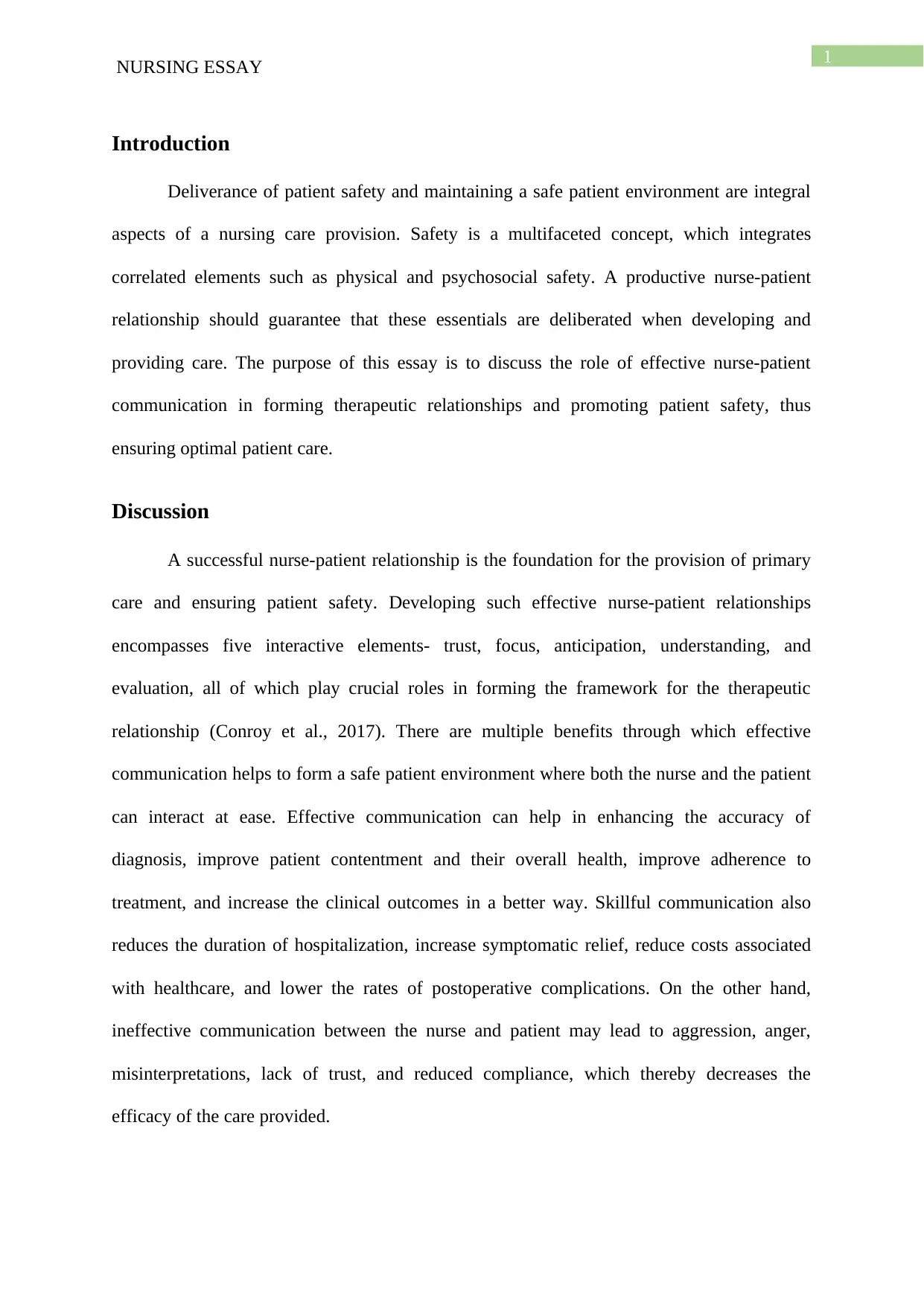
1
NURSING ESSAY
Introduction
Deliverance of patient safety and maintaining a safe patient environment are integral
aspects of a nursing care provision. Safety is a multifaceted concept, which integrates
correlated elements such as physical and psychosocial safety. A productive nurse-patient
relationship should guarantee that these essentials are deliberated when developing and
providing care. The purpose of this essay is to discuss the role of effective nurse-patient
communication in forming therapeutic relationships and promoting patient safety, thus
ensuring optimal patient care.
Discussion
A successful nurse-patient relationship is the foundation for the provision of primary
care and ensuring patient safety. Developing such effective nurse-patient relationships
encompasses five interactive elements- trust, focus, anticipation, understanding, and
evaluation, all of which play crucial roles in forming the framework for the therapeutic
relationship (Conroy et al., 2017). There are multiple benefits through which effective
communication helps to form a safe patient environment where both the nurse and the patient
can interact at ease. Effective communication can help in enhancing the accuracy of
diagnosis, improve patient contentment and their overall health, improve adherence to
treatment, and increase the clinical outcomes in a better way. Skillful communication also
reduces the duration of hospitalization, increase symptomatic relief, reduce costs associated
with healthcare, and lower the rates of postoperative complications. On the other hand,
ineffective communication between the nurse and patient may lead to aggression, anger,
misinterpretations, lack of trust, and reduced compliance, which thereby decreases the
efficacy of the care provided.
NURSING ESSAY
Introduction
Deliverance of patient safety and maintaining a safe patient environment are integral
aspects of a nursing care provision. Safety is a multifaceted concept, which integrates
correlated elements such as physical and psychosocial safety. A productive nurse-patient
relationship should guarantee that these essentials are deliberated when developing and
providing care. The purpose of this essay is to discuss the role of effective nurse-patient
communication in forming therapeutic relationships and promoting patient safety, thus
ensuring optimal patient care.
Discussion
A successful nurse-patient relationship is the foundation for the provision of primary
care and ensuring patient safety. Developing such effective nurse-patient relationships
encompasses five interactive elements- trust, focus, anticipation, understanding, and
evaluation, all of which play crucial roles in forming the framework for the therapeutic
relationship (Conroy et al., 2017). There are multiple benefits through which effective
communication helps to form a safe patient environment where both the nurse and the patient
can interact at ease. Effective communication can help in enhancing the accuracy of
diagnosis, improve patient contentment and their overall health, improve adherence to
treatment, and increase the clinical outcomes in a better way. Skillful communication also
reduces the duration of hospitalization, increase symptomatic relief, reduce costs associated
with healthcare, and lower the rates of postoperative complications. On the other hand,
ineffective communication between the nurse and patient may lead to aggression, anger,
misinterpretations, lack of trust, and reduced compliance, which thereby decreases the
efficacy of the care provided.
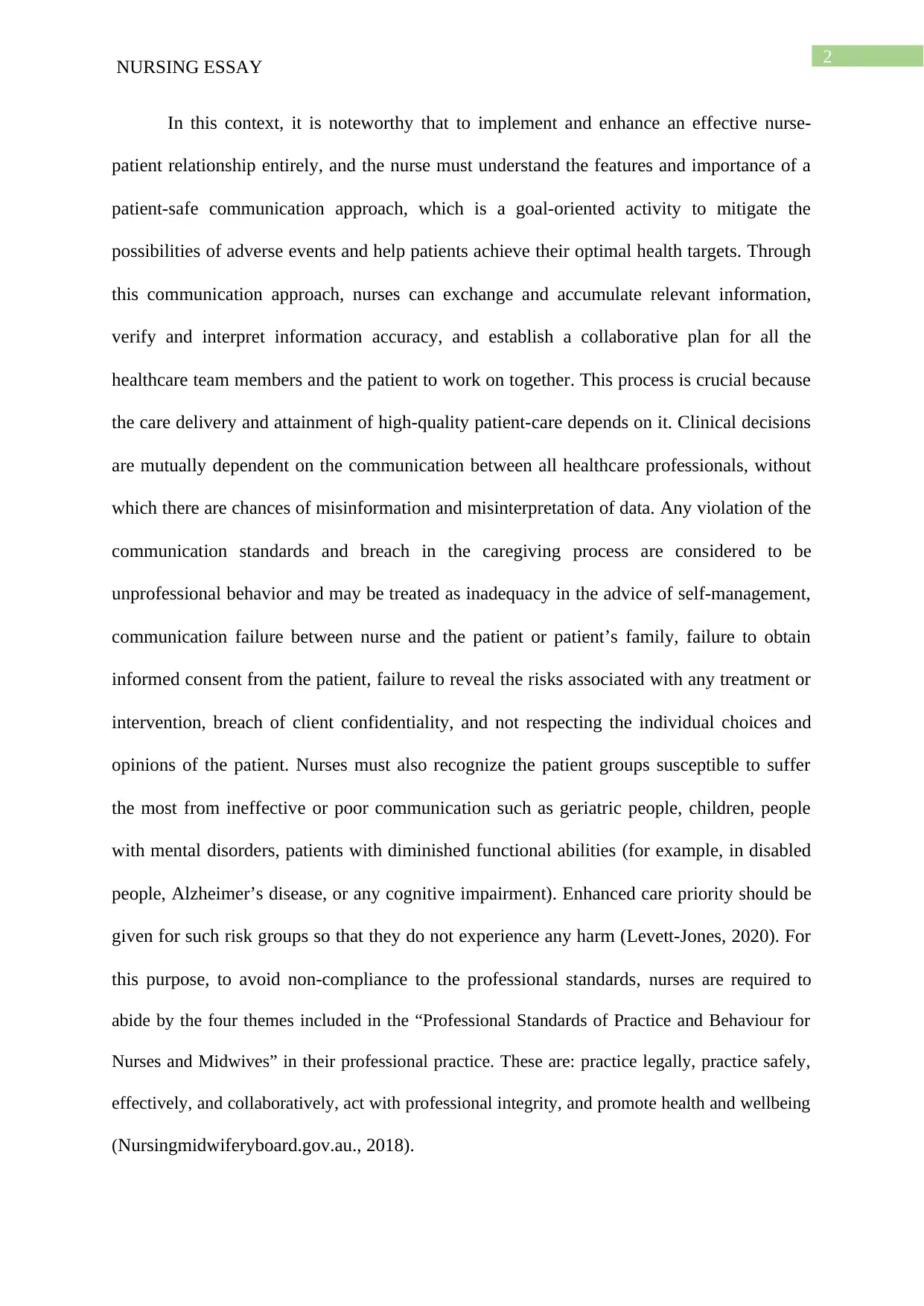
2
NURSING ESSAY
In this context, it is noteworthy that to implement and enhance an effective nurse-
patient relationship entirely, and the nurse must understand the features and importance of a
patient-safe communication approach, which is a goal-oriented activity to mitigate the
possibilities of adverse events and help patients achieve their optimal health targets. Through
this communication approach, nurses can exchange and accumulate relevant information,
verify and interpret information accuracy, and establish a collaborative plan for all the
healthcare team members and the patient to work on together. This process is crucial because
the care delivery and attainment of high-quality patient-care depends on it. Clinical decisions
are mutually dependent on the communication between all healthcare professionals, without
which there are chances of misinformation and misinterpretation of data. Any violation of the
communication standards and breach in the caregiving process are considered to be
unprofessional behavior and may be treated as inadequacy in the advice of self-management,
communication failure between nurse and the patient or patient’s family, failure to obtain
informed consent from the patient, failure to reveal the risks associated with any treatment or
intervention, breach of client confidentiality, and not respecting the individual choices and
opinions of the patient. Nurses must also recognize the patient groups susceptible to suffer
the most from ineffective or poor communication such as geriatric people, children, people
with mental disorders, patients with diminished functional abilities (for example, in disabled
people, Alzheimer’s disease, or any cognitive impairment). Enhanced care priority should be
given for such risk groups so that they do not experience any harm (Levett-Jones, 2020). For
this purpose, to avoid non-compliance to the professional standards, nurses are required to
abide by the four themes included in the “Professional Standards of Practice and Behaviour for
Nurses and Midwives” in their professional practice. These are: practice legally, practice safely,
effectively, and collaboratively, act with professional integrity, and promote health and wellbeing
(Nursingmidwiferyboard.gov.au., 2018).
NURSING ESSAY
In this context, it is noteworthy that to implement and enhance an effective nurse-
patient relationship entirely, and the nurse must understand the features and importance of a
patient-safe communication approach, which is a goal-oriented activity to mitigate the
possibilities of adverse events and help patients achieve their optimal health targets. Through
this communication approach, nurses can exchange and accumulate relevant information,
verify and interpret information accuracy, and establish a collaborative plan for all the
healthcare team members and the patient to work on together. This process is crucial because
the care delivery and attainment of high-quality patient-care depends on it. Clinical decisions
are mutually dependent on the communication between all healthcare professionals, without
which there are chances of misinformation and misinterpretation of data. Any violation of the
communication standards and breach in the caregiving process are considered to be
unprofessional behavior and may be treated as inadequacy in the advice of self-management,
communication failure between nurse and the patient or patient’s family, failure to obtain
informed consent from the patient, failure to reveal the risks associated with any treatment or
intervention, breach of client confidentiality, and not respecting the individual choices and
opinions of the patient. Nurses must also recognize the patient groups susceptible to suffer
the most from ineffective or poor communication such as geriatric people, children, people
with mental disorders, patients with diminished functional abilities (for example, in disabled
people, Alzheimer’s disease, or any cognitive impairment). Enhanced care priority should be
given for such risk groups so that they do not experience any harm (Levett-Jones, 2020). For
this purpose, to avoid non-compliance to the professional standards, nurses are required to
abide by the four themes included in the “Professional Standards of Practice and Behaviour for
Nurses and Midwives” in their professional practice. These are: practice legally, practice safely,
effectively, and collaboratively, act with professional integrity, and promote health and wellbeing
(Nursingmidwiferyboard.gov.au., 2018).
⊘ This is a preview!⊘
Do you want full access?
Subscribe today to unlock all pages.

Trusted by 1+ million students worldwide
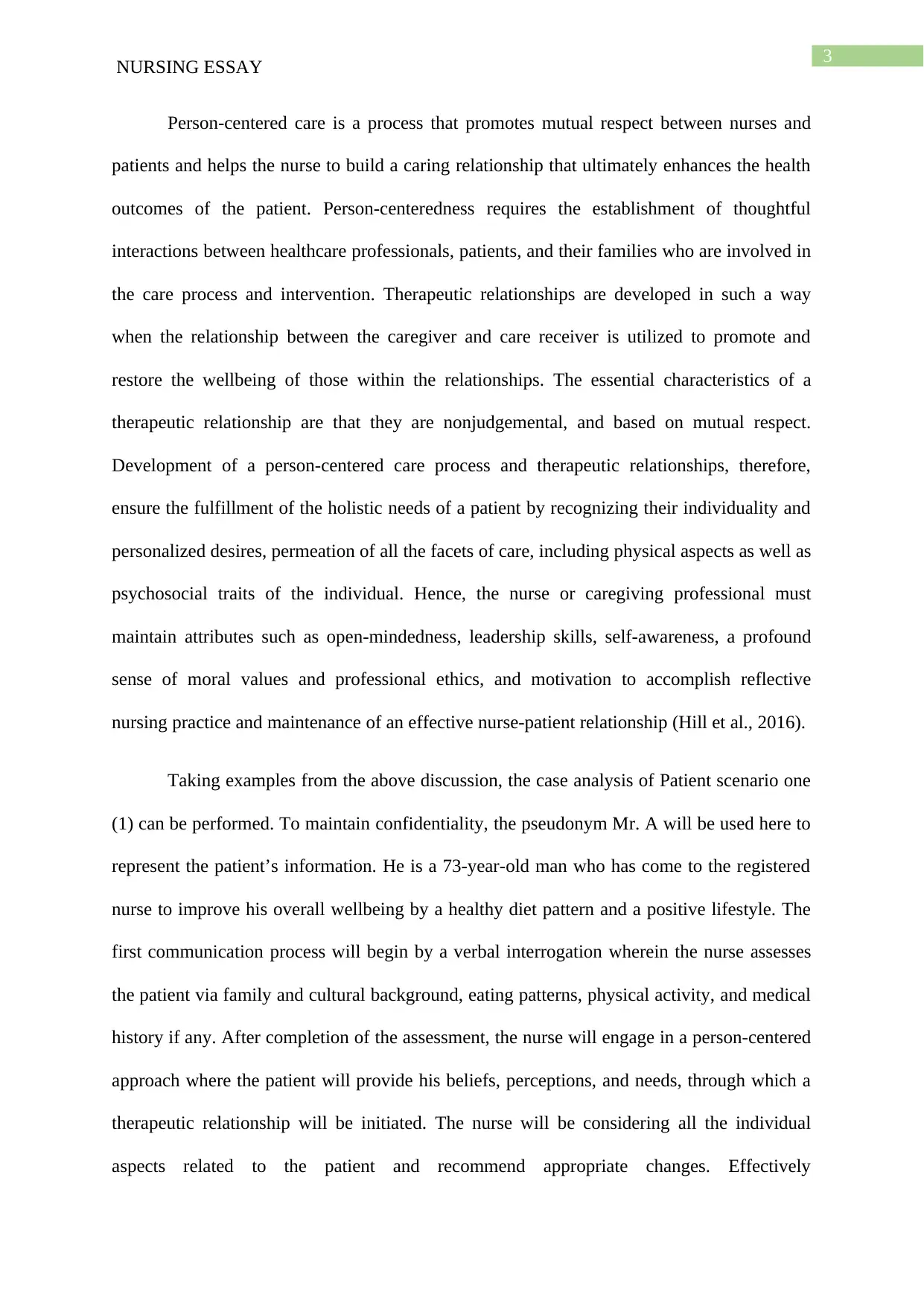
3
NURSING ESSAY
Person-centered care is a process that promotes mutual respect between nurses and
patients and helps the nurse to build a caring relationship that ultimately enhances the health
outcomes of the patient. Person-centeredness requires the establishment of thoughtful
interactions between healthcare professionals, patients, and their families who are involved in
the care process and intervention. Therapeutic relationships are developed in such a way
when the relationship between the caregiver and care receiver is utilized to promote and
restore the wellbeing of those within the relationships. The essential characteristics of a
therapeutic relationship are that they are nonjudgemental, and based on mutual respect.
Development of a person-centered care process and therapeutic relationships, therefore,
ensure the fulfillment of the holistic needs of a patient by recognizing their individuality and
personalized desires, permeation of all the facets of care, including physical aspects as well as
psychosocial traits of the individual. Hence, the nurse or caregiving professional must
maintain attributes such as open-mindedness, leadership skills, self-awareness, a profound
sense of moral values and professional ethics, and motivation to accomplish reflective
nursing practice and maintenance of an effective nurse-patient relationship (Hill et al., 2016).
Taking examples from the above discussion, the case analysis of Patient scenario one
(1) can be performed. To maintain confidentiality, the pseudonym Mr. A will be used here to
represent the patient’s information. He is a 73-year-old man who has come to the registered
nurse to improve his overall wellbeing by a healthy diet pattern and a positive lifestyle. The
first communication process will begin by a verbal interrogation wherein the nurse assesses
the patient via family and cultural background, eating patterns, physical activity, and medical
history if any. After completion of the assessment, the nurse will engage in a person-centered
approach where the patient will provide his beliefs, perceptions, and needs, through which a
therapeutic relationship will be initiated. The nurse will be considering all the individual
aspects related to the patient and recommend appropriate changes. Effectively
NURSING ESSAY
Person-centered care is a process that promotes mutual respect between nurses and
patients and helps the nurse to build a caring relationship that ultimately enhances the health
outcomes of the patient. Person-centeredness requires the establishment of thoughtful
interactions between healthcare professionals, patients, and their families who are involved in
the care process and intervention. Therapeutic relationships are developed in such a way
when the relationship between the caregiver and care receiver is utilized to promote and
restore the wellbeing of those within the relationships. The essential characteristics of a
therapeutic relationship are that they are nonjudgemental, and based on mutual respect.
Development of a person-centered care process and therapeutic relationships, therefore,
ensure the fulfillment of the holistic needs of a patient by recognizing their individuality and
personalized desires, permeation of all the facets of care, including physical aspects as well as
psychosocial traits of the individual. Hence, the nurse or caregiving professional must
maintain attributes such as open-mindedness, leadership skills, self-awareness, a profound
sense of moral values and professional ethics, and motivation to accomplish reflective
nursing practice and maintenance of an effective nurse-patient relationship (Hill et al., 2016).
Taking examples from the above discussion, the case analysis of Patient scenario one
(1) can be performed. To maintain confidentiality, the pseudonym Mr. A will be used here to
represent the patient’s information. He is a 73-year-old man who has come to the registered
nurse to improve his overall wellbeing by a healthy diet pattern and a positive lifestyle. The
first communication process will begin by a verbal interrogation wherein the nurse assesses
the patient via family and cultural background, eating patterns, physical activity, and medical
history if any. After completion of the assessment, the nurse will engage in a person-centered
approach where the patient will provide his beliefs, perceptions, and needs, through which a
therapeutic relationship will be initiated. The nurse will be considering all the individual
aspects related to the patient and recommend appropriate changes. Effectively
Paraphrase This Document
Need a fresh take? Get an instant paraphrase of this document with our AI Paraphraser
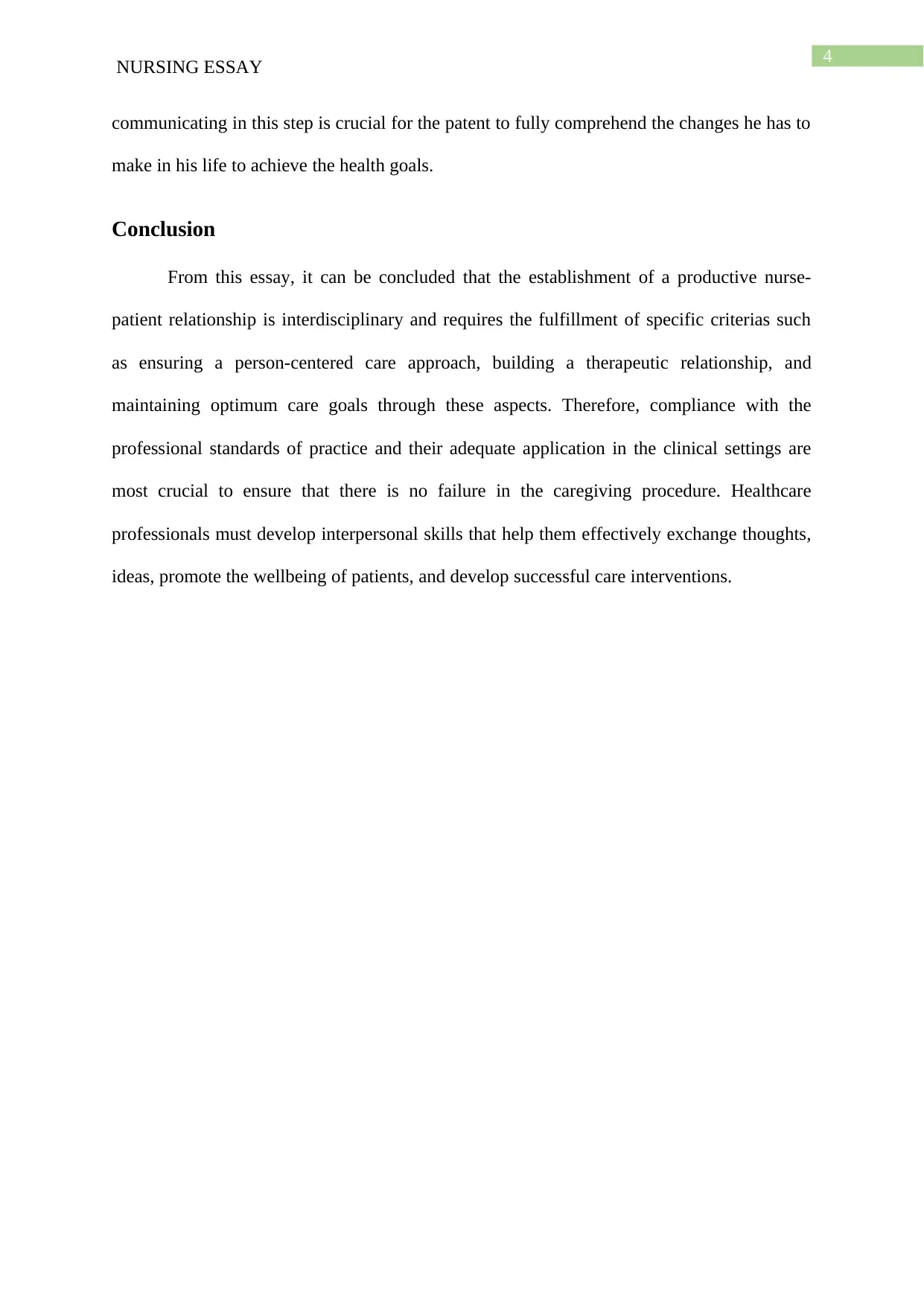
4
NURSING ESSAY
communicating in this step is crucial for the patent to fully comprehend the changes he has to
make in his life to achieve the health goals.
Conclusion
From this essay, it can be concluded that the establishment of a productive nurse-
patient relationship is interdisciplinary and requires the fulfillment of specific criterias such
as ensuring a person-centered care approach, building a therapeutic relationship, and
maintaining optimum care goals through these aspects. Therefore, compliance with the
professional standards of practice and their adequate application in the clinical settings are
most crucial to ensure that there is no failure in the caregiving procedure. Healthcare
professionals must develop interpersonal skills that help them effectively exchange thoughts,
ideas, promote the wellbeing of patients, and develop successful care interventions.
NURSING ESSAY
communicating in this step is crucial for the patent to fully comprehend the changes he has to
make in his life to achieve the health goals.
Conclusion
From this essay, it can be concluded that the establishment of a productive nurse-
patient relationship is interdisciplinary and requires the fulfillment of specific criterias such
as ensuring a person-centered care approach, building a therapeutic relationship, and
maintaining optimum care goals through these aspects. Therefore, compliance with the
professional standards of practice and their adequate application in the clinical settings are
most crucial to ensure that there is no failure in the caregiving procedure. Healthcare
professionals must develop interpersonal skills that help them effectively exchange thoughts,
ideas, promote the wellbeing of patients, and develop successful care interventions.
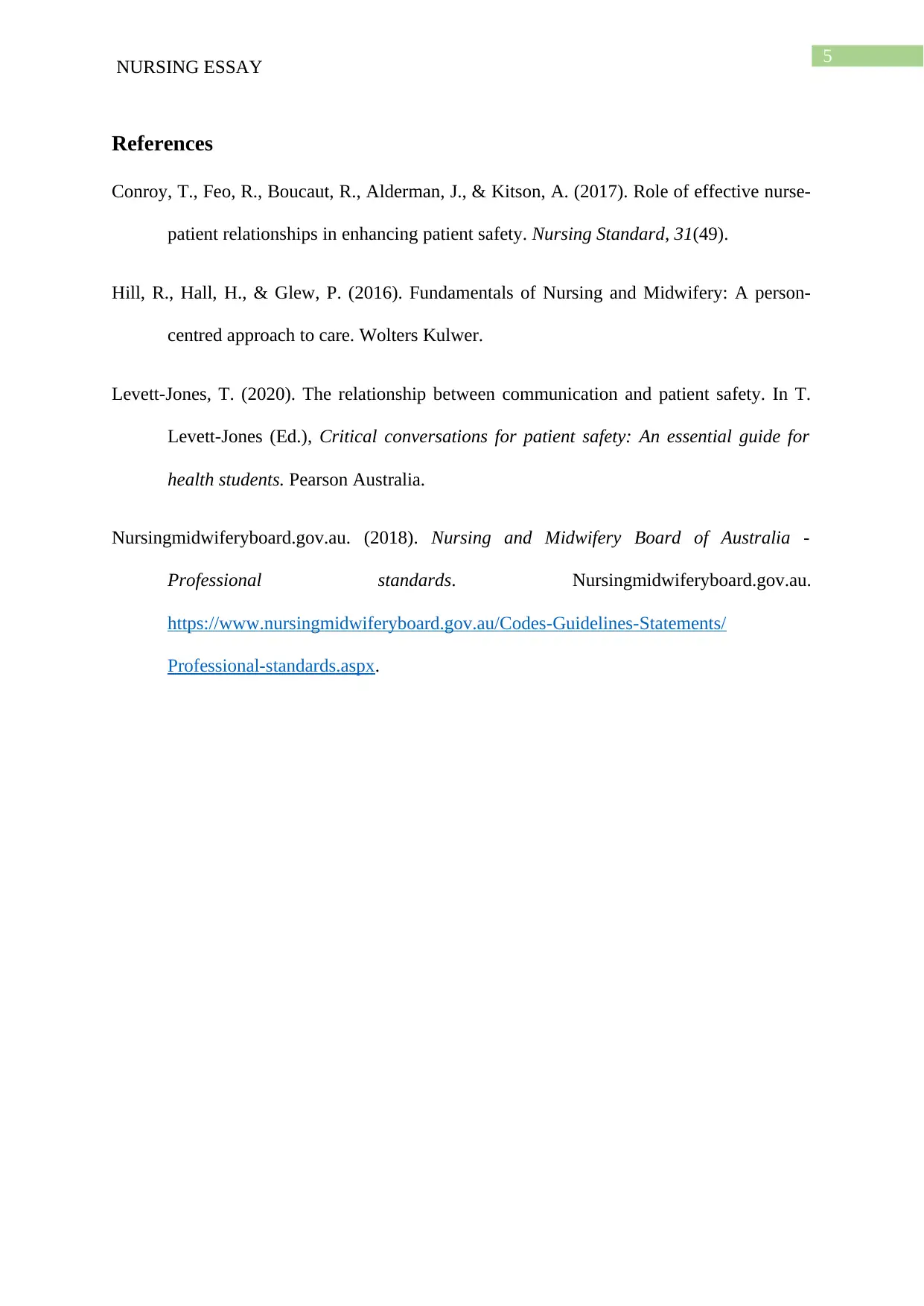
5
NURSING ESSAY
References
Conroy, T., Feo, R., Boucaut, R., Alderman, J., & Kitson, A. (2017). Role of effective nurse-
patient relationships in enhancing patient safety. Nursing Standard, 31(49).
Hill, R., Hall, H., & Glew, P. (2016). Fundamentals of Nursing and Midwifery: A person-
centred approach to care. Wolters Kulwer.
Levett-Jones, T. (2020). The relationship between communication and patient safety. In T.
Levett-Jones (Ed.), Critical conversations for patient safety: An essential guide for
health students. Pearson Australia.
Nursingmidwiferyboard.gov.au. (2018). Nursing and Midwifery Board of Australia -
Professional standards. Nursingmidwiferyboard.gov.au.
https://www.nursingmidwiferyboard.gov.au/Codes-Guidelines-Statements/
Professional-standards.aspx.
NURSING ESSAY
References
Conroy, T., Feo, R., Boucaut, R., Alderman, J., & Kitson, A. (2017). Role of effective nurse-
patient relationships in enhancing patient safety. Nursing Standard, 31(49).
Hill, R., Hall, H., & Glew, P. (2016). Fundamentals of Nursing and Midwifery: A person-
centred approach to care. Wolters Kulwer.
Levett-Jones, T. (2020). The relationship between communication and patient safety. In T.
Levett-Jones (Ed.), Critical conversations for patient safety: An essential guide for
health students. Pearson Australia.
Nursingmidwiferyboard.gov.au. (2018). Nursing and Midwifery Board of Australia -
Professional standards. Nursingmidwiferyboard.gov.au.
https://www.nursingmidwiferyboard.gov.au/Codes-Guidelines-Statements/
Professional-standards.aspx.
⊘ This is a preview!⊘
Do you want full access?
Subscribe today to unlock all pages.

Trusted by 1+ million students worldwide
1 out of 6
Related Documents
Your All-in-One AI-Powered Toolkit for Academic Success.
+13062052269
info@desklib.com
Available 24*7 on WhatsApp / Email
![[object Object]](/_next/static/media/star-bottom.7253800d.svg)
Unlock your academic potential
Copyright © 2020–2025 A2Z Services. All Rights Reserved. Developed and managed by ZUCOL.





